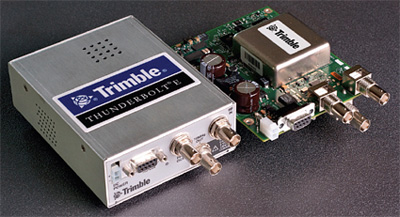
In my column "Error Correction in Mobile DTV (RF Technology, Oct. 20), Mike Simon from Rohde and Schwarz took issue with my comment about operating Mobile DTV systems without GPS NTP and exciter references. A check of the Mobile DTV standard ATSC A/153 Part 2, Section 5.3.2.13.1 showed he was, as expected, correct.
In ATSC Mobile DTV, the NTP reference is used to synchronize mobile streams from different stations to reduce channel change time and potentially allow signals from multiple transmitter sites to be used as a terrestrial positioning system when GPS signals are not available.
ATSC A/153 Part 2 states: "Each ATSC M/H frame shall be aligned at an integer number of AT ticks from the AT epoch, such that emission at the air interface of the broadcast antenna of the starting instant of the first symbol of the first data field sync of the 8-VSB data field containing the beginning of an M/H frame coincides with an AT tick. The tolerance of this symbol timing shall be no greater than 1 symbol time RMS, and should be no greater than 15 nanoseconds RMS." (AT refers to "ATSC Time", as defined in the standard.)

LG Electronics' LG DP570MH portable DVD player with Mobile DTV To accurately time the transmission of Mobile DTV signals an accurate NTP time reference locked to GPS is required. The time server must be "Stratum 1", meaning it is connected directly to a time reference such as GPS or CDMA, not through a network where routers and other network components can delay the signal. Attempting to lock a Rohde and Schwarz AEM-100 to the NTIS time server (time.nist.gov) over the Internet resulted in an error message saying the delay was too great.
REMOVING ERRORS IN GPS SIGNAL
Note that the accuracy at the output of a GPS receiver alone may not be sufficient. A NASA paper "The Role of GPS in Precise Time and Frequency Dissemination" notes, "The accuracy of GPS time signals is related to the ability of the receiver to accurately track the received C/A PRN code. Accuracies in the 100-nanosecond range are possible with undegraded GPS signals and correct receiver position." One way to obtain more accurate data is to use time transfer services like those offered by the U.S. Naval Observatory. The other way is to use the GPS signals to train a very stable crystal or rubidium standard oscillator so that minor errors and variations in the GPS signal due to propagation are removed. That's the most practical solution for broadcasters.

Trimble Thunderbolt A Google search for some low-cost, high-performance timing options will return a number of options using low-cost GPS units like the Garmin GPS 18x LVC and Linux or FreeBSD based computers. However, because GPS accuracy is only specified as +/– 1 microsecond, a stable disciplined clock will be needed to approach the one symbol/15 nanosecond accuracy needed to comply with A/153. The crystal oscillator in a PC may not meet this requirement. I question the need for such accuracy given that differences in transmitter locations and delay through transmission line to the antenna will cause much greater errors. The tolerance for the 8-VSB symbol rate in an ATSC-MH system is only 2.8 ppm (A/153 Part 2 Section 5.3.2.13).
SIMPLE BUT EXPENSIVE SOLUTIONS
A simpler, although much more expensive, approach is to purchase a dedicated NTP time server. Several companies sell these devices. Symmetricom manufactures a range of GPS locked NTP and frequency references. Their SyncServer S250 uses a GPS reference and provides both NTP and the 1 pulse per second (1 PPS) reference required for ATSC mobile DTV. The accuracy with reference to UTC time is 50 nanoseconds. Accuracy with respect to GPS time will be better, since GPS time has to be adjusted to match UTC time. The Unison GPS Network Time Server from EndRun Technologies specifies a GPS receiver accuracy (1 PPS output) better than 30 nanoseconds but a UTC accuracy better than 100 nanoseconds.

Symmetricom SyncServer S250
For an accurate, stable 10 MHz or 1 PPS reference, I've used Trimble's "Thunderbolt" products. They are reliable, relatively inexpensive, and work well. The Thunderbolt is used in communications systems needing an accurate frequency standard. It has a disciplined clock to average out GPS errors. It seems to me it should be possible to use the Thunderbolt disciplined clock to reference a computer based NTP server. This should provide much greater accuracy and lower error than a GPS alone with the right settings on the NTP server. If anyone has tried this please let me know.
Is your station rolling out Mobile DTV? Let me know your experiences. E-mail me at dlung@transmitter.com.
The professional video industry's #1 source for news, trends and product and tech information. Sign up below.

Doug Lung is one of America's foremost authorities on broadcast RF technology. As vice president of Broadcast Technology for NBCUniversal Local, H. Douglas Lung leads NBC and Telemundo-owned stations’ RF and transmission affairs, including microwave, radars, satellite uplinks, and FCC technical filings. Beginning his career in 1976 at KSCI in Los Angeles, Lung has nearly 50 years of experience in broadcast television engineering. Beginning in 1985, he led the engineering department for what was to become the Telemundo network and station group, assisting in the design, construction and installation of the company’s broadcast and cable facilities. Other projects include work on the launch of Hawaii’s first UHF TV station, the rollout and testing of the ATSC mobile-handheld standard, and software development related to the incentive auction TV spectrum repack. A longtime columnist for TV Technology, Doug is also a regular contributor to IEEE Broadcast Technology. He is the recipient of the 2023 NAB Television Engineering Award. He also received a Tech Leadership Award from TV Tech publisher Future plc in 2021 and is a member of the IEEE Broadcast Technology Society and the Society of Broadcast Engineers.
